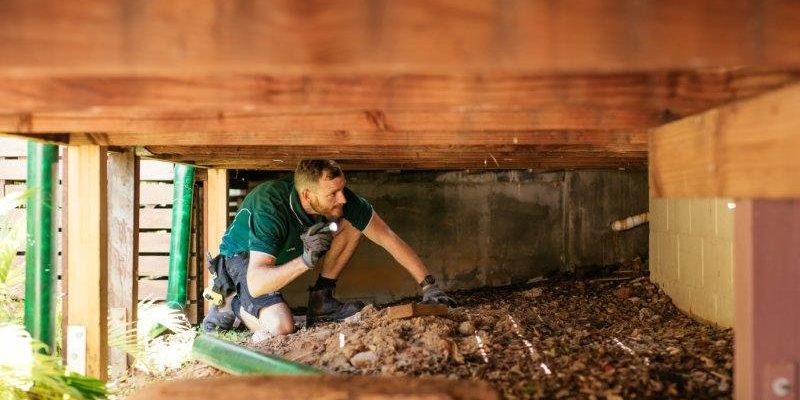Termite Inspection | The Right Way to Do It for Your Business
- August 15, 2020
- in Pest Control
- by Ashley Dando

Termites are tiny little bugs so surely, they can’t cause much damage. Think again. Every two months, a Sunshine Coast home is designated uninhabitable due to termite damage and they can attack your business too.
Are you a business owner and are you worried about termite inspection? You need to know about termites. Read on to learn what you need to know and do.
There are about 300 different species of termites in Australia. Here in Queensland, we have very destructive termites including subterranean termites and dry wood termites. They are widespread and a significant risk to all types of buildings.
Subterranean termites, as the name suggests, live underground. They need a reliably moist environment to live in which they get from the soil.
Unfortunately, subterranean termites don’t stay underground all the time. They are capable of building a network of tunnels above ground level using mud. They move through these tunnels known as “galleries” and can wreak havoc by damaging the building’s structure.
Drywood termites have very different behaviour to subterranean termites. They don’t need to maintain an underground moist living environment and so don’t have to make their home in the soil. They can even exist within a piece of wood.
A drywood termite infestation can arrive in your building in timber that has termites within it. Even furniture can contain drywood termites and be the method by which they are introduced to a building. Termites can also fly so they don’t need to be manually introduced.
A subterranean termite colony is typically much bigger than a drywood termite colony. A well-established subterranean termite colony can have as many as two million termites in it. A drywood termite colony might have only a few hundred termites in it.
Termites cause damage to the structure of your building. Wood contains cellulose and it’s this that the termites are after. They consume the wood and some other materials that are used in the construction of your building leaving an unstable and weakened structure behind.
As well as the timber used in building construction, termites also eat the wood in furniture. They sometimes eat paper, fabric, and even some other materials. Sometimes plastic and rigid foam get the termite’s attention.
How can you spot these tiny building destroyers?
Look out for the little tunnels they build using mud. Look for them in the building foundations and around frames.
Hollow sounding timbers are a giveaway when the termites have eaten the inside of the timber away. Weakened timbers can also result in sagging ceilings, floors, and doorways. Any wooden parts of the building such as door frames and skirting boards can be easily dented by pressing because the interior has been removed.
Other parts of the building can show signs of damage even though they are not made of wood. If a part of the building is supported by wood that has been damaged then the result can show in the form of cracks. Check painted areas and plaster for these tell-tale cracks.
You might think that it’s bad enough having a termite infestation but there’s more bad news.
As a business owner, you have a responsibility to provide a safe working environment for your employees. A termite infestation could put the safety of your employees at risk due to a failure of the structure of the building.
This makes a termite inspection part of your health and safety risk assessment procedures.
Life on the Sunshine Coast has its compensations. It has great surf, great restaurants, and festivals galore. One downside is you have to be serious about pest control.
Have a routine termite inspection, at least annually. This will help identify any potential problems and may also provide you with some advice about preventing infestations.
If you notice the tell-tale signs of termite infestation you need professional help immediately. They will start by conducting an inspection.
A termite inspection, conducted by a trained professional, will identify any signs of infestation. The inspection process will also identify anything that might attract termites to the building. Following the inspection, you will receive an action plan.
Your inspection report may conclude that you do not have a termite infestation. This good news will be followed by recommendations for how to prevent an infestation in the future. Termite prevention is always better than treating a termite infestation once its already taken hold of your building.
A professional pest control response to an infestation could be to use a termite baiting system. The termites are encouraged to take bait which has been treated with a toxin that the termites take back to the nest where it kills the termites.
Pest control products that kill termites do not have to be toxic to other wildlife or long-lasting. Bio-degradable products are available. These are safe to use around children, pets, and plants.
Prevention of termites can be as simple as making your building unattractive to termites.
Remove sources of moisture. Ventilate the building well and clear away debris. Clear away any plants or wood that are in contact with the building.
More sophisticated methods of prevention are also available. Termite Barriers can be installed. These are chemical deterrents to termites that are installed all around your building to repel or kill termites.
With a better understanding of the potential threat of termites, conduct a check. Call a pest control professional and arrange a full termite inspection. Even if they find that you don’t have termites, take their advice on prevention.
Talk to us about your termites, right now.